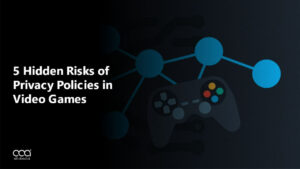As we are almost halfway through 2024, artificial intelligence (AI) is not just a buzzword anymore—it’s a pervasive force that is changing the game for all economies, industries, and societies.
AI is all set to boost the world’s economy! According to Statista, the AI sector is already worth about 200 billion U.S. dollars in 2024, and it’s expected to soar to over 1.8 trillion by 2030.
The growth of the artificial intelligence market is mainly fueled by more companies using big data analytics and ongoing advancements in AI research and technology around the world.
There are 15 key AI statistics and facts for 2024 that are particularly significant and interesting. But before we move on and jump on the number, let’s address a basic question first, shall we?
Exploring the World of Artificial Intelligence: What Exactly is AI?
AI is a technology that enables machines to perform tasks that usually require human intelligence. For example, learning, thinking, problem-solving, and decision-making. If I put this into simple words, it’s all about programming computers to mimic human actions and thought processes.
A simple example of AI is a voice assistant on your smartphone, like Siri or Google Assistant.
What’s Next in AI? Unveiling the Key AI Statistics for 2024
The unstoppable growth of AI is evident in its increasing integration into global business operations. Here are some compelling AI statistics highlighting its rapid expansion:
Market Value and Growth Projections
1. Global AI Market: Expected to grow from $241.8 billion in 2023 to nearly $740 billion by 2030, with a compound annual growth rate of 17.3%.
2. US AI Market: Projected to reach $299.64 billion by 2026.
3. AI Telecommunications Sector: Currently valued at $2.5 billion, with expected continued growth.
4. Wearable AI Devices: The market is expected to soar to $180 billion by 2025.
5. AI Startups: The number has surged 14 times since the year 2000.
Economic Impact
6. Global GDP Contribution: AI is expected to contribute $15.7 trillion by 2030, a 14% increase (equivalent to the current output of China and India combined).
7. Regional GDP Boosts: Largest benefits projected for China (26% increase by 2030) and North America (14.5% increase), totaling $10.7 trillion (nearly 70% of global AI impact).
8. US GDP Boost: AI could boost the US GDP by 21% by 2030.
Employment
9. Job Displacement and Creation: AI is expected to displace 85 million jobs but create 97 million new ones by 2025, resulting in a net increase of 12 million jobs.
10. AI Employment: Up to 97 million people may be employed in the AI sector by 2025.
Industry-Specific Projections
11. Self-Driving Cars: 10% of vehicles are expected to be driverless by 2030; the market is projected to grow from 20.3 million units to 62.4 million.
12. Generative AI: Estimated economic impact of $2.6 trillion to $4.4 trillion across various industries.
Business Adoption and Investment
13. Technology Adoption: Over 75% of companies plan to adopt AI, big data, and cloud computing within the next five years.
14. Current Business Usage: Over 48% of businesses are using AI to optimize big data usage.
15. IT Expenditures: Global expenditures on IT products and services focused on AI are expected to grow by 26.5% in 2026, surpassing $300 billion.
My Take on Key AI statistics for 2024
What I’ve observed so far is that the AI industry is set for massive growth and will greatly impact the economy soon. A lot of this growth comes from advancements in AI tools, which I’ve been testing a lot.
The value of the AI market is expected to triple by 2030, and it’s making big economic impacts, especially in countries like China and the U.S. That’s why using the best AI tools in 2024 is so important—they help drive innovation and make industries more efficient.
AI Statistics of the Top Industries
- AI Marketing Statistics for 2024
- AI in Healthcare Statistics for 2024
- AI Statistics in Real Estate for 2024
- AI Statistics in Finance for 2024
- AI Education Statistics for 2024
- AI Statistics in Manufacturing for 2024
- AI in Cybersecurity Statistics 2024
7 Game-Changing AI Marketing Statistics (You Will Love 4th the Most!)
Marketing AI is revolutionizing the way businesses connect with customers, offering unprecedented insights and automation. Here are AI marketing statistics showing how AI is transforming marketing strategies, enhancing personalization, and optimizing campaign effectiveness:
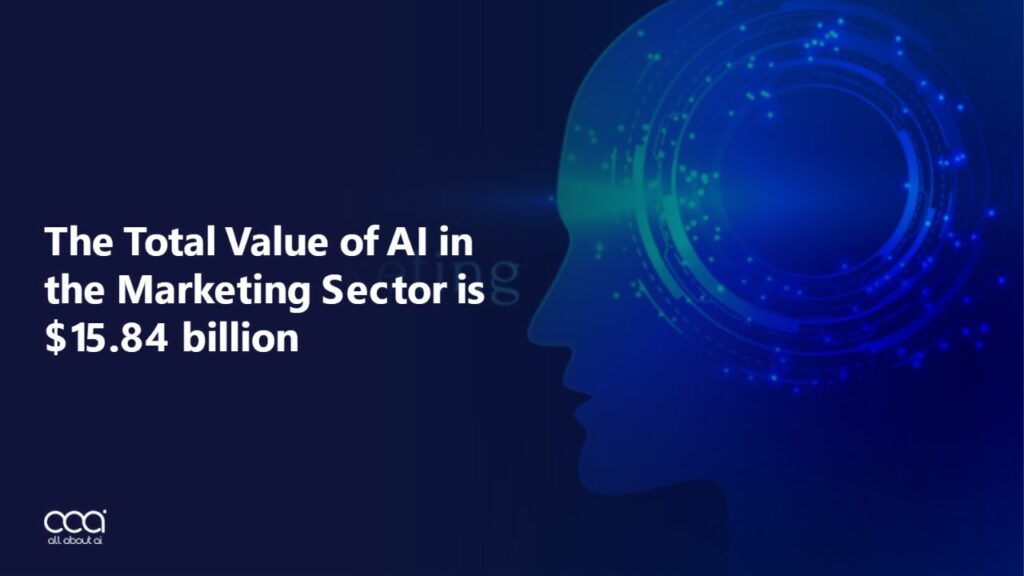
Source: Statista
16. The AI marketing sector is currently valued at $15.84 billion and is expected to exceed $100 billion within the next five years.
17. By 2028, AI in the marketing sector is anticipated to generate $107 billion in global market revenue.
18. Chatbots are forecasted to achieve a market size of $1.25 billion globally by 2025.
19. A vast majority of marketers (90%) implement AI tools for automating interactions with customers.
20. Over 80% of marketers worldwide incorporate some form of AI in their digital marketing efforts.
21. 47% of marketers across the U.S., U.K., India, and Canada trust AI for targeted advertising.
22. ChatGPT is used by 34.5% of marketers, making it the most commonly reported AI tool.
My Take on the AI Marketing Stats
I believe the integration of AI into marketing is a game-changer. It’s exciting to see the industry projected to hit over $100 billion within five years – that shows just how impactful these tools are. Are you already using AI to automate tasks? I’ve been testing some of the best AI generator tools in 2024, and it’s impressive to see how they free up my team to focus on big-picture strategy.
Plus, the way AI powers targeted advertising and content generation? Amazing! We’re using tools like ChatGPT to take our content to the next level. The future of marketing is definitely going to be driven by AI as we continue exploring the capabilities of these powerful tools. There are even more astonishing must-know AI marketing statistics for every marketer to stay at the top of their game.
11+ Insightful AI in Healthcare Statistics (The 10th Will Shock You!)
Artificial intelligence (AI) is rapidly becoming an essential tool in healthcare, helping to close the gap between patients and providers. With its ability to enhance efficiency and effectiveness, AI-driven solutions are attracting significant investments in the healthcare sector.
Here’s a quick overview of the key AI in Healthcare Statistics for 2024:
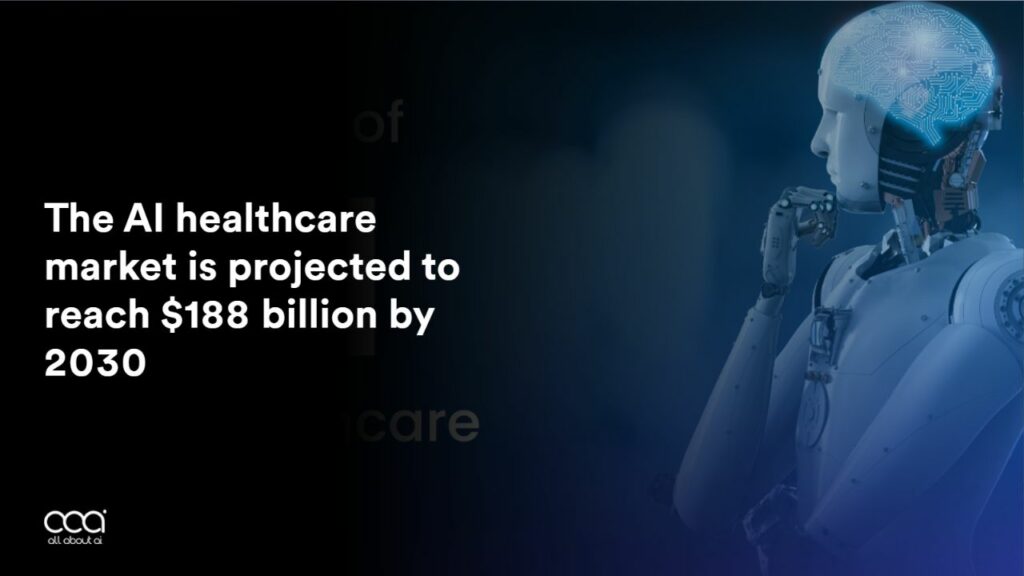
Source: Statista
23. The healthcare AI market is poised for substantial growth, with projections indicating a global market value of $188 billion by 2030, showing a compound annual growth rate (CAGR) of 37%.
24. The U.S. holds a dominant 58% revenue share in the global AI healthcare market.
25. As of 2024, North America leads the AI in the healthcare market with a value of $6.8 billion and continues to dominate the sector globally.
26. AI-driven chatbots are anticipated to save $3.6 billion globally for healthcare organizations.
27. The robot-assisted surgery market could be worth $40 billion by 2026.
28. AI could save $16 billion by reducing medication dosing errors.
29. The market for AI in precision medicine is projected to grow to $14.5 billion by 2030.
30. AI and machine learning could help reduce healthcare costs by $13 billion by 2025.
31. AI-integrated medical imaging is expected to grow at a 26.5% CAGR from 2021 to 2028.
32. By 2025, 90% of hospitals are expected to employ AI for early diagnosis and remote monitoring.
33. Currently, about 20% of healthcare organizations are leveraging AI technologies in their operations.
34. Healthcare professionals are optimistic about the future, with 79% believing that robotics and AI will notably enhance the industry.
My Take on AI in Healthcare Statistics
These stats are just the tip of the iceberg, and to fully grasp the scale of AI’s impact, you must know and understand AI in healthcare statistics from a big-picture view. I’ve observed that the healthcare sector is on the cusp of a significant transformation, driven by the rapid integration of AI technologies that promise to streamline medical care and make it more cost-effective.
As part of this evolution, I’ve been actively testing some of the best AI productivity tools in 2024, aiming to quantify their impact through detailed AI-driven statistics.
These tools not only optimize administrative processes but also support advanced clinical decision-making. By leveraging AI in operational and clinical areas, healthcare organizations can significantly reduce overhead costs and improve patient care quality, showcasing a robust integration of technology and healthcare practices.
AI Statistics in Real Estate: 15 Data Points You Can’t Miss
The real estate sector has traditionally been slow to embrace new technologies. However, the synergy between artificial intelligence (AI) and the real estate industry is becoming increasingly apparent. Here are some key insights:
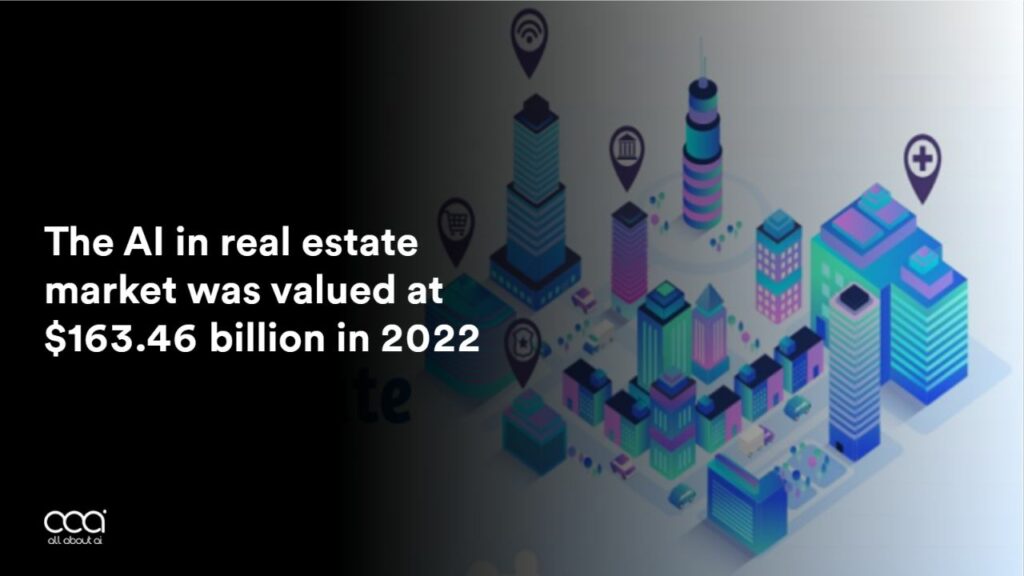
Source: Forbes
35. The AI in real estate market was valued at $163.46 billion in 2022. It is projected to reach $1335.89 billion by 2029, growing at a compound annual growth rate (CAGR) of 35%.
36. By 2030, it’s expected that around 90% of real estate agencies will be utilizing AI.
37. Chatbots held 28.98% of the market share in 2022 and are expected to maintain their dominance throughout the forecast period.
38. About 49% of real estate business owners have noted that AI adoption has helped reduce their operating costs.
39. 63% of property companies have reported a revenue increase following the implementation of AI solutions.
40. 36% of tenants and homebuyers now value a property’s digital connectivity more than its location.
41. 80% of buyers and 89% of millennials rely on online resources, including AI-driven tools, for house hunting.
42. AI-powered predictive analytics can achieve up to 97% accuracy in property valuations.
43. 53% of facility managers using AI report a revenue increase of 10%.
44. 85% of real estate professionals believe AI will significantly impact their industry by 2030.
45. AI technologies are expected to account for 38% of total efficiency savings in the real estate sector by 2030.
46. Implementing AI could reduce operating costs in real estate by up to 15%.
47. AI is predicted to cut the time property managers spend on screening by 75%.
48. Over the next five years, the adoption of AI in real estate is projected to rise by 81%.
49. 90% of real estate companies anticipate AI will revolutionize the leasing process within the next five years.
My Take on AI Statistics in Real Estate
I’ve observed that the real estate sector is experiencing a significant transformation driven by AI technologies, leading to more efficient, data-driven operations. The rise of chatbots and digital tools for property searches illustrates a shift towards technology-driven transactions.
Businesses report cost savings and increased revenue from AI adoption, while consumers increasingly value digital capabilities over physical location.
This change aligns with broader digital transformation trends, with real estate professionals recognizing AI’s transformative potential and anticipating its deep integration into the industry’s future.
AI Statistics in Finance: 9 Key Stats Shaping the Future
The integration of artificial intelligence (AI) in finance is transforming how financial institutions operate, enabling more efficient processes and innovative solutions. Here are the stats showing AI’s impact on the financial sector is profound and continuously evolving.
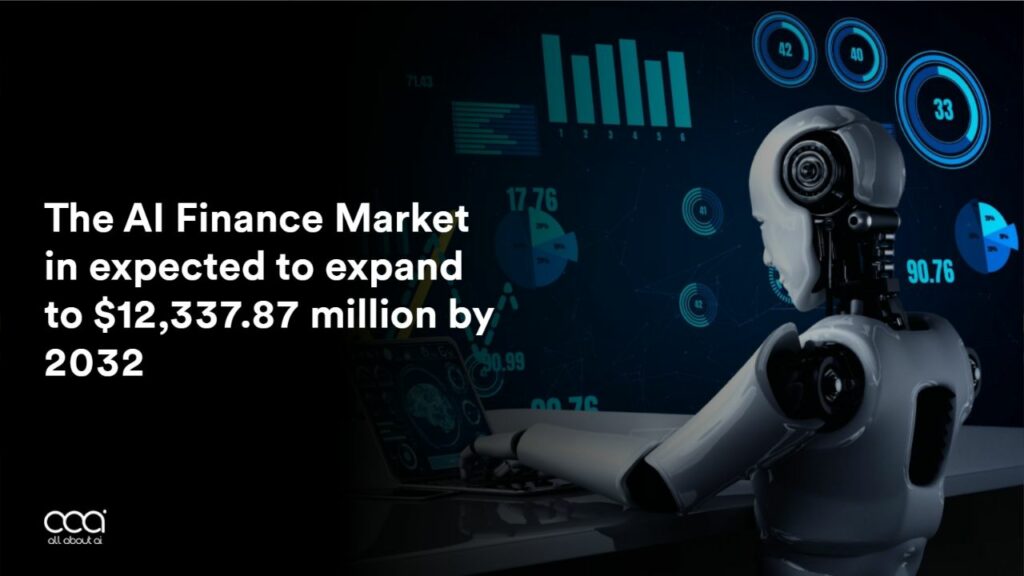
Source: Pwc
50. The AI market in banking and finance is expected to expand from $712.4 million to approximately $12,337.87 million by 2032. It is expected to grow at a compound annual growth rate (CAGR) of 33%.
51. Banks could save up to $487 billion by the end of 2024, mainly through AI improvements in front and middle-office operations, which are expected to contribute to over 90% of these savings.
52. In the U.S., the market for generative AI in banking and finance started at $244.48 million in 2023 and is projected to reach $3,183.44 million by 2032, maintaining a CAGR of 33%. North America is anticipated to lead the market throughout this period.
53. According to NVIDIA’s State of AI in Financial Services Report, more than 90% of financial services companies are evaluating or actively using AI.
54. According to Business Insider, 56% of financial services companies have adopted AI for risk management.
55. Business Insider reports that 75% of banks holding assets over $100 billion are actively implementing AI strategies.
56. Temenos states that 91% of U.S. banks deploy AI to detect fraud.
57. Forbes Advisor forecasts that the global AI fintech market will reach $22.6 billion by 2025.
58. According to Forbes Advisor, 70% of financial services firms utilize machine learning for cash flow predictions, credit score adjustments, and fraud detection.
My Take on AI Statistics in Finance
The financial sector is poised for transformative change with AI driving rapid growth, enhancing operational efficiency, and fostering significant cost savings, particularly in front and middle-office operations. Major banks are widely adopting AI for risk management, fraud detection, and strategic decision-making, streamlining complex financial processes.
AI’s influence also extends to the fintech realm, crucial for refining financial models like credit scoring and cash flow management. This widespread adoption is crafting a more secure and responsive financial environment, signaling a new era of advanced technological integration in financial management.
15+ Vital AI Education Statistics (Keep an Eye on the 11th!)
AI has rapidly integrated into the educational landscape, as evidenced by these remarkable statistics demonstrating its widespread adoption in a short period. Here are the Key Stats:
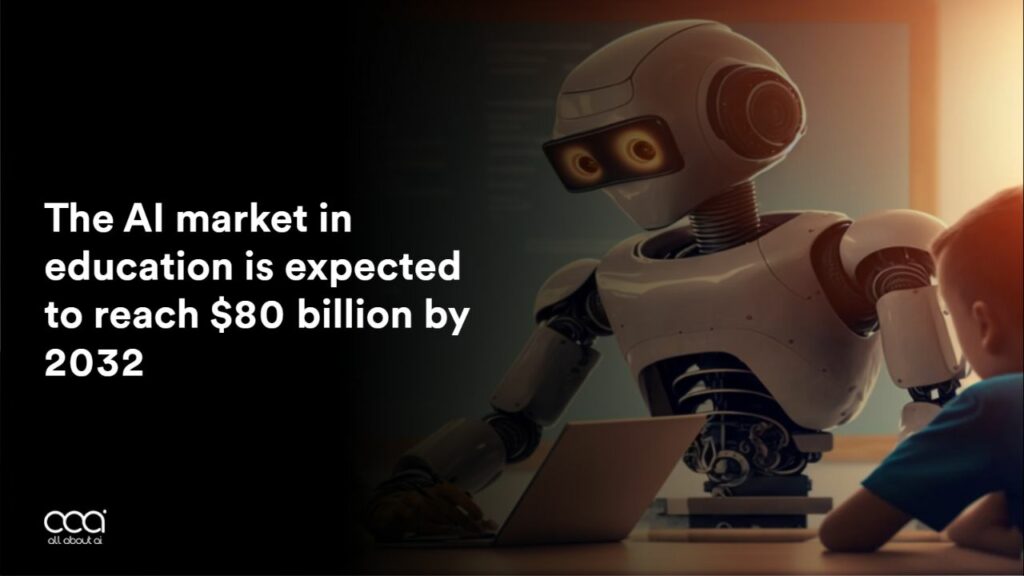
Source: Statista
59. The AI market in education is anticipated to reach $80 billion by 2032, with a 20% CAGR from 2023 to 2032.
60. AI is significantly driving the growth of the e-learning market, which is forecasted to be valued at $239.3 billion by 2027.
61. The generative AI market is expected to grow at a compound annual growth rate (CAGR) of 76.9%, reaching $51.8 billion by 2028.
62. 43% of college students in the US report using AI tools such as ChatGPT to aid their studies.
63. 90% of those who study with the help of ChatGPT consider it more effective than traditional tutoring.
64. 50% of educators now employ AI technology for organizing their lesson plans.
65. AI-based grade prediction systems have successfully identified and assisted over 34,700 students at risk of failing.
66. A survey of over 300 users showed that AI-generated content is as engaging as human-created content in educational videos.
67. More than 11% of college and school papers worldwide contain AI-generated content.
68. Male students are more likely to use AI than female students.
69. 78% of parents think using AI writing tools for schoolwork is a form of cheating.
70. 36% of university students report threats of failure if caught using AI inappropriately.
71. 800,000 students worldwide have used AI voice tech to improve their English.
72. 61% of US college students believe AI will become the norm.
73. 60% of US college students say their teachers haven’t advised them on how to use AI ethically.
74. 66% of students worry that AI will impact their future careers.
75. Nearly half of learning management systems will incorporate AI by the end of 2024.
76. Adaptive AI learning systems can improve test scores by 62%.
77. AI marking tools can help teachers spend 70% less time grading assignments.
My Take on AI Education Statistics
The AI market in education is booming, expected to reach $80 billion by 2032 with a significant 20% CAGR. For me, this shows a significant surge in the development of AI within the education sector, particularly driven by advancements in AI writing tools. In 2024, these tools have become pivotal in transitioning to more dynamic and efficient learning environments.
This shift is reshaping educational practices and outcomes. My focus on rigorously testing and evaluating the best AI writing tools in 2024 aims to ensure that they are effectively meeting the evolving demands of both students and educators.
9 Must-Know AI Statistics in Manufacturing (Watch Out for the 9th!)
The adoption of artificial intelligence (AI) in education is revolutionizing learning environments and teaching methodologies. Here are key statistics showcasing how AI is personalizing education, enhancing student engagement, and improving educational outcomes across the globe.
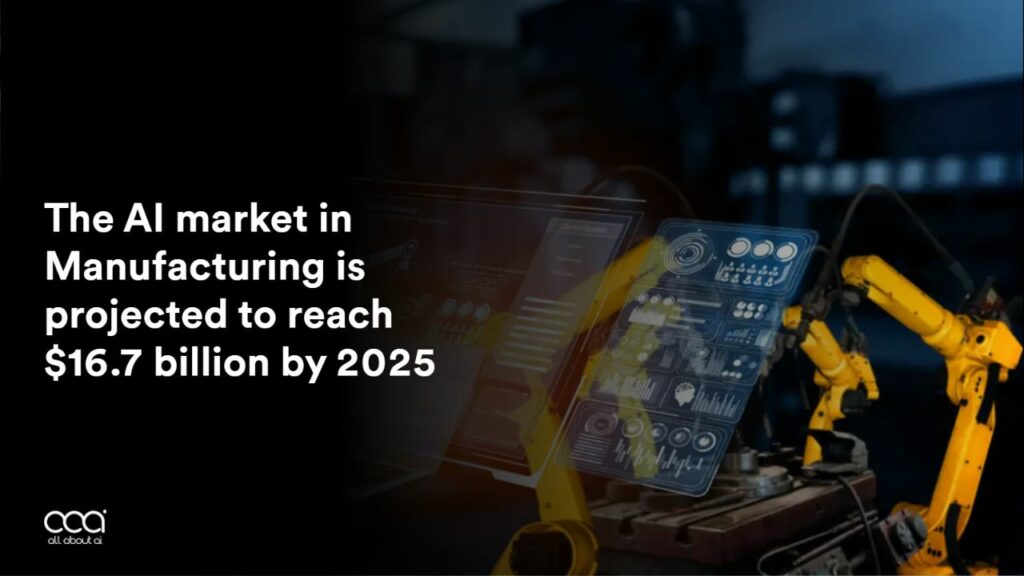
Source: Marketsandmarkets
78. The AI market in Manufacturing is projected to reach $16.7 billion by 2025.
79. AI technologies in manufacturing could increase global GDP by $15.7 trillion by 2030.
80. 51% of manufacturers are currently implementing AI technology.
81. Companies using AI in manufacturing have increased operational efficiency by 20%.
82. Manufacturers can achieve 20-50% cost savings through AI implementation.
83. 29% of manufacturers implement AI primarily for safety and quality improvements.
84. 63% of manufacturers believe AI can improve supply chain processes.
85. The motor vehicles and parts manufacturing sector is anticipated to save $450 million annually through AI adoption.
86. AI could increase manufacturing productivity by up to 40% by 2035.
My Take on AI Statistics in Manufacturing
The integration of AI in manufacturing is transforming the industry, bringing about a revolution in operational efficiency and cost management. Manufacturers are increasingly turning to AI not only to streamline production but also to enhance safety and quality standards.
This shift is also proving pivotal in refining supply chain processes, allowing companies to respond more agilely to market demands. As the industry continues to adopt AI, the expectations for productivity improvements are high, signaling a shift towards a more efficient and technologically advanced manufacturing landscape.
AI in Cybersecurity Statistics: 15 Facts Driving Tomorrow’s Innovations
Artificial intelligence (AI) has become a pivotal tool in the cybersecurity industry, bolstering defenses against increasingly sophisticated threats. Here are key statistics that highlight the role of AI in enhancing security measures and the challenges it presents in cyber defense strategies.

Source: Forbes
87. The global market for AI-based cybersecurity products is estimated to reach $133.8 billion by 2030, up from $14.9 billion.
88. 82% of IT decision-makers plan to invest in AI-driven cybersecurity within the next two years.
89. 48% of these decision-makers plan to invest before the end of 2023.
90. 64% of executives have already implemented AI for security capabilities.
91. 29% are evaluating the implementation of AI in cybersecurity.
92. Only 7% are not considering using AI for cybersecurity.
93. The use of security AI and automation increased from 59% in 2020 to 70% in 2022.
94. Organizations with fully deployed security AI and automation increased from 25% in 2021 to 31% in 2022.
95. Those without security AI and automation decreased from 35% to 30% in 2024.
96. Leaders in security AI adoption reported an increase in ROSI by 40%.
97. Top AI adopters reported that AI plus automation helped them reduce their total cybersecurity costs by at least 15%.
98. The top applications for AI in cybersecurity include network security (75%), data security (71%), and endpoint security (68%).
99. 69% of executives say AI results in higher efficiency for cybersecurity analysts in their organizations.
100. 61% of organizations say they cannot identify critical threats without AI.
101. 51% of executives make extensive use of AI in cyber threat detection.
My Take on AI Statistics in Cybersecurity
I’m amazed that the cybersecurity landscape is rapidly evolving, with AI taking a central role, which is even more evident from the top AI in cybersecurity statistics. IT decision-makers are increasingly relying on AI to enhance security frameworks, focusing on network, data, and endpoint security.
This shift not only improves efficiency and reduces costs but also significantly boosts the return on investment in security. In this context, the utilization of the best AI video tools in 2024 is pivotal, as these tools enhance real-time threat detection and response through advanced video analytics, marking a significant advance in proactive cybersecurity measures.
Fast Track to the Future: Quick AI Adoption Rate across Industries
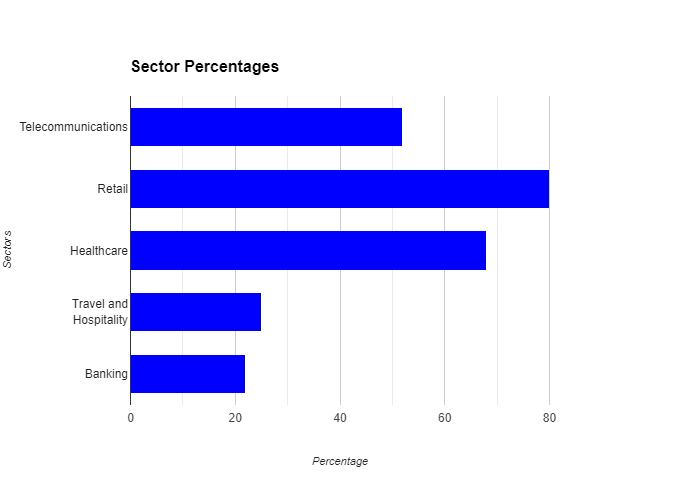
The Bar Chart shows the adoption rate of the different industries and the overall impact of AI on each.
35% of all businesses now leverage AI technology, reflecting a growing recognition of its strategic importance. Below are some of the industries and their adoption rates for AI.
- Telecommunications: 52% of telephone companies enhance customer service with AI-powered chatbots, demonstrating AI’s role in improving client interactions.
- Retail: 80% of retail executives plan to implement AI automation by 2025, aiming to revolutionize customer experiences and streamline operations.
- Healthcare: 68% of healthcare organizations employ AI, utilizing advanced algorithms to improve diagnostics and patient care.
- Automotive: The automotive sector shows robust growth with a 48% increase in machine learning adoption, driving innovations in self-driving technology and manufacturing processes.
- Banking: AI is poised to boost the banking sector’s revenue by 22% ($1 billion) within three years, showcasing its potential to enhance financial services.
- Retail: Leads AI implementation, with 72% of retailers using AI, setting a benchmark for other industries.
- Travel and Hospitality: 25% are embracing chatbot technology to improve customer service and operational efficiency.
Echoes of AI: My Thoughts on Tomorrow’s Tech
The impressive statistics and data surrounding AI certainly showcase its potential as one of the most transformative technologies we’ve seen to date. Its influence is unmistakably present in giants like Amazon and Apple and is gradually weaving its way into various other industries.
As big data companies and global economies adjust to this shift, they are crafting policies that harmonize well with AI-driven innovations.
Yet, I think it’s too simplistic and ultimately unhelpful to hastily categorize AI as simply “good” or “evil.” Every aspect of AI’s development demands thoughtful consideration and vigilant oversight. It’s crucial to approach concerns with care, ensuring we fully appreciate the immense potential and diverse applications of AI.
I am very hopeful about the future of AI. I see it as a powerful tool that will revolutionize industries, economies, and societies at large. Certainly, there are challenges and potential negative impacts, but I am confident that with time and continued thoughtful human oversight, we will find effective solutions.
Like any technology before it, AI’s success and positive impact on our world depend on our ability to integrate it thoughtfully and responsibly into our lives.
FAQs
What is the significance of AI statistics?
How I see AI changing our future?
What is AI's impact on employment?
References


